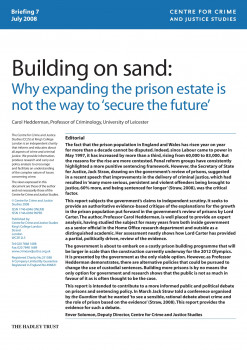Building on sand: Why expanding the prison estate is not the way to 'secure the future'

The government's analysis of factors driving up the prison population is 'inadequate' and 'highly misleading' according to a report published by the Centre for Crime and Justice Studies.
The report, by Professor Carol Hedderman of the University of Leicester and a former Assistant Director of research in the Home Office, challenges the government's explanation for the factors driving up the prison population set out in the recent Review of Prisons by Lord Carter. Building on sand: Why expanding the prison estate is not the way to 'secure the future', states that Lord Carter's analysis is 'largely unevidenced'.
According to the report:
The increased use of imprisonment has not been driven by more offences being brought to justice. For example, the numbers convicted for burglary have dropped by an average of 1,400 per year since 1995.
The increased use of custody has been affected by the sentencing of some serious offences, but there is little sign that, overall, the courts are dealing with more serious cases now than they were in the mid 1990s. They are simply responding more punitively.
The biggest single change in sentencing behaviour concerns the number and the length of custodial sentences for less serious property offences and other cases which are too trivial to be sent to the Crown Court.
Prison reconviction rates have escalated as the population has increased.
The public appetite for prison is more limited and more susceptible to reasoned argument than the government acknowledges.
Expanding the prison estate will generate not satiate demand.
The report suggests a number of possible policy reforms to slow the rise in prison numbers. These include:
- Immediately introducing a structured sentencing framework, perhaps under the aegis of the current Sentencing Guidelines Council.
- Limiting magistrates' powers to use custody for non-violent summary offences and in particular discourage sentencers from using custody for theft and handling.
- Developing a recognised measure - or `QALY'- of public safety, similar to that used by National Institute for Health and Clinical Excellence for medical treatments, so that the impact and value of imprisonment and other sanctions can be compared in a common currency.
- Greater use of local communication initiatives to inform the public about just how frequently the courts are resorting to custody.
Professor Carol Hedderman said:
'The current public debate on the use of prison is sterile. The moment you query why the prison population is going up you risk being branded as being soft on crime and putting prisoners' interests before that of the public. We need to move the debate on to more fertile territory.
'One important question is who are we using prison for and is it making us any safer? The government makes statements about reserving prison for the serious and dangerous but the figures tell a different story.
'We also need to ask just how much this rise in imprisonment is costing us and whether it represents good value for money. There is very little information available to answer these questions but the figures which are around suggest that there are much more cost effective ways of dealing with many of those we currently send to prison.'